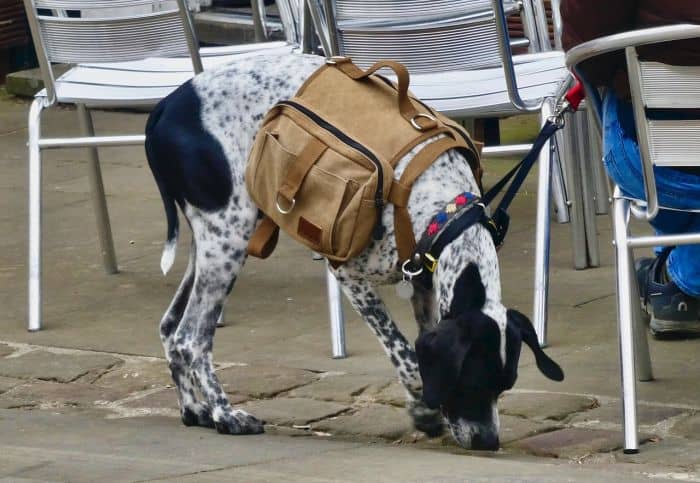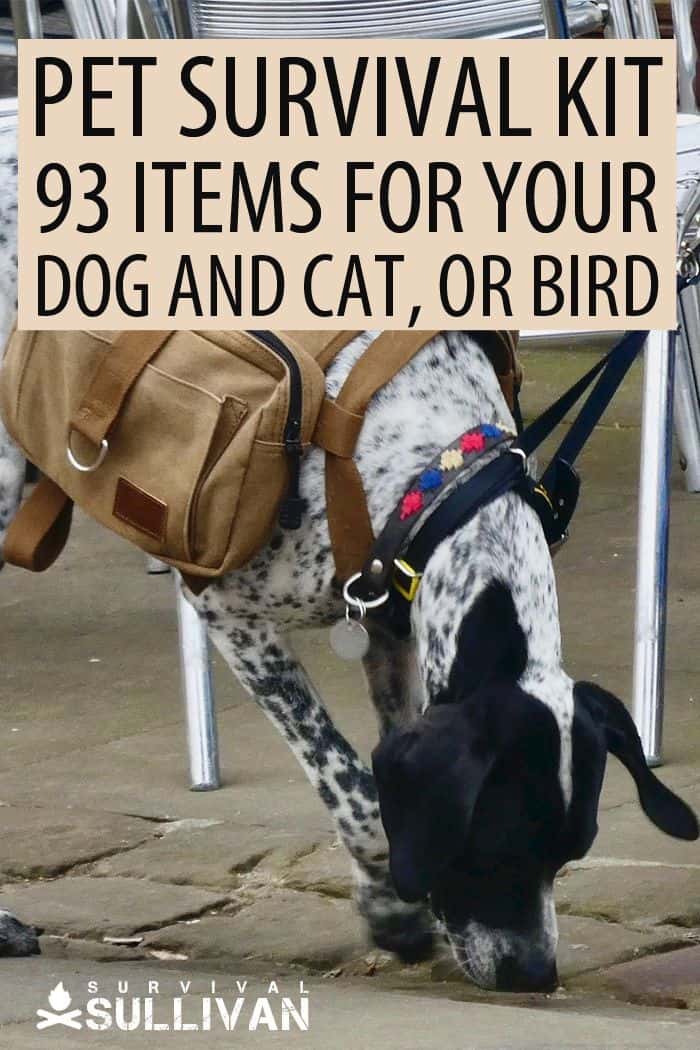When thinking ahead for emergency survival for their families, most preppers have a general plan and many have started stockpiling general supplies that would be essential if disaster struck. But what about the furkids?
Many assume that pets can just eat human food and will live off the land if they ever had to be off the grid or in a post-TEOTWAWKI situation. In some aspects, getting back to an all-natural, self-sustaining lifestyle will be a welcome freedom to any pet.

But in reality, modern day dogs and cats are part of our family and need to be considered when planning and included when gathering supplies, just as the family has been. They also need to be effectively prepared by training and being mentally ready.
In this article we will explore planning and preparing for a pets emergency survival, and how you can ensure your furry family members will be healthy and cared for.
Pet Training for Emergencies Preparation
Like training drills with the family for disasters or emergencies, there are a few methods you can use that will greatly help your pet be mentally strong when he needs to be. You want your pet to be an asset to survival living, not a hindrance.
The main thing you can do is make sure he knows a few commands. These simple commands can save your life if you are avoiding detection, or there is chaos and you need him to know to listen to you. You want that trust and obedience, it can save his life.
The Top 5 Commands Your Pet Should Know in an Emergency:
- Come when called
- Be silent when told
- Stay still when told
- Heel by your side
- ”Drop it” in case he picks up tainted meat or roadkill, etc.
Pets can pick up anxiety and fear. In a sea of people, noise or chaos happening around them when disaster strikes, you pet can fare a lot better if the noises do not faze him as much.
To allow him to focus on you and not bolt away, there are a few things you can desensitize him to early on for mental preparedness.
7 Things to Help Desensitize Your Pet to Noise:
- Guns and the smell of gunpowder
- Use fireworks to emulate explosives and accompanying bright light
- Tarps and flapping clothing
- Cars and traffic noises
- Air horns, sirens and whistles
- Wild animal sounds
- Chopping wood and snapping branches
Here is a great article on packing survival supplies for pets:
Pet Survival Kit Essentials
Many pets are just as precious as any family member. They make awesome companions and you will want to provide for your friend. If you only have a small space to store family BOBs for an emergency.
Pack a small to medium one for your best friend. By storing foods both people and pets can eat, and stockpiling like materials, it is a lot easy to add your pets BOB into a prepping plan.
Here are the essentials for both dogs and cats when making a survival BOB for your pet.
- Pet food– its best to have a 72 hour supply in a BOB and stockpile from there. Cheaper foods are made with mostly grains, lower protein sources, and fats and will turn rancid if stored improperly. Quality, high protein food will last quite a while in air tight containers.
- Can opener for wet food. Their own can opener will help keep pets and peoples separate. Or be a spare, just in case.
- Pet clothing including shoes– for dogs that have been inside, their feet will not be hardened to traveling long distances or being outside for any length of time. Depends on the SHTF scenario, you would do better to be prepared as the terrain may change. Canine officers footpads suffered greatly after 9/11 and they went through many pairs of shoes searching through the rough wreckage.
- Leashes and a collar I would check out making leashes and collars with paracord, always handy to have.
- Collapsible bowls for easy storage
- Supplements
- Treats
- Documents, shot records with pictures I would make sure to have documentation of vaccination shots, history, age and any medical concerns.
- Instructions on care, name, and any special needs if anything were to happen, or you needed to leave them with someone for a bit while venturing out, it’s best to have a care and feeding routine for your pets comfort.
- Any medications stock up on 3 months of any medications. See if you can get oral versions so they can be stored long-term.
- Dental tools there are special sprays that will help kill gingivitis for pets. I pack actual metal dental tools and you can pop off plaque.
- Flea and tick treatments as these pests carry disease and parasites, it important to have a supply of treatments and topical agents to guard against infestation.
- Carrier A carrier is important for providing a den for your dog and a safe haven for scared animals. Containing your animal when traversing in unknown parts, maybe with panicked crowds, may keep them alive. You do not want them to flee, or be taken.
- Dawn dish liquid to remove fleas, oils, or any skunk sprays.
- Dry shampoos and wipes
Here are a few additions to think on and some extra essential items just for individual types of pets:
Dog Bug Out Bag Items
- Tie out for exercise or secure bathroom time
- Raincoat
- Dog bed
- Blankets
- Chew toys for anxious chewing
- Dental chewies to help clean teeth
- A dog can be outfitted with a vest and pack many things to help out.
- Grooming and cleaning items
- Brushes
- Nail clippers
- Cotton balls for ears
- Muzzle in case of emergency injury etc.
- Body harness in case you need to lift him or have him haul or pull
You’ll find more things to add here.
Cat Bug Out Bag Items
- Entertainment- laser pointers, toys to play with, and mental stimulation will help calm a pet.
- Litter waste disposal is especially crucial for cats. Anything it can use. Garbage bags, a scoop, smell killing baking soda, and litter.
- Litter box
- Cat bed
- Blankets
- Cat clothing- sweaters
- Grooming and cleaning items
- Brushes
- Nail clippers
- Cotton balls for ears
Bird Bug Out Bag Items
- Specialty food if he is used to foraging like dried fruits and veggies
- A quality dry feed
- A good attachable water bottle
- Dishes and attachables bowls
- Wire cage with a box for nesting/hiding
- A cover for the cage to avoid night drafts
- A heat lamp would be good
- Nesting items for warmth
- Spray bottle for misting/bathing
- Items for his breed to regulate beak growth
- Toys and mirrors to entertain
- Carrier he can move in (if it’s a bird not living in a cage i.e. a chicken)
- Litter for his cage: newspapers or cedar chips
- Nail clippers
- Many birds carry a small ID band on their leg with info, and contact
- Bird safe cleaning supplies
- Vitamin water drops
Extra small pet BOB considerations (like hedgehogs, hamsters, rats, hedgehogs, guinea pigs, gerbils etc.)
- Rodent chow- Dry food pellets in block or chunk form
- Mixed grain food with veggies and fruits
- Special omnivore/herbivore food for the breed (ie hedgehogs can use dried mealworms)
- A good attachable water bottle
- A wire cage with good ventilation
- Tubes for tunneling
- Nocturnal pets need a solid-floored wheel or some form of exercise
- Nocturnal pets need a light source and we use a heating pad under the outside of a cage corner
- Nocturnal pets are used to chewing, so items to chew that are safe are unpainted wood items, untreated natural woods. Dental health can be optimized with dog biscuits
- Nocturnal pets love to climb: so multi-levels, bars or branches in the cage
- Rodent approved toys that can include things to shred, ropes, swings and nets to climb
- Unscented baby wipes for a quick bath
A Few More Supplies
Pet food- wet and dry Canning for long term storage and using sealed containers for dry food will help avoid molding, turning rancid, and any pest invasions.
Kitty litter or absorbent litter this actually can be used for your kitty as well as in your won waste disposal system, as it absorbs liquid and kills odor. If you buy the unscented type it has a few extra uses.
Kitty litter has unique properties
- Bentonite is the active ingredient and with its ability to clump, it can double as a sealant for ponds or as a sealer for cracks.
- It can be made into a poultice and heal wounds, boils, and stings by drawing the toxin out.
Pet First Aid Kit
Although most human first aid kits will have the basic supplies and many things are interchangeable, you should make a pet based first aid kit so you have all the supplies you need in any emergency or critical situation.
Having a separate pet first aid kit will also keep any cross contamination at bay during treatment. Brushing up on pet CPR would be a smart move in addition to packing a pet BOB and first aid kit.
Here are the basics for constructing your pet’s first aid kit:
- Hypoallergenic tape and sports tape
- Sterile eye wash
- Vaseline or other petroleum type jelly
- Triple antibacterial ointment
- 1% hydrocortisone cream
- Rubbing alcohol
- Witch hazel for ears
- Betadine
- Antihistamine spray and stick up pills like Benadryl (it can also act as a sedative in emergencies)
- Aspirin (buffered type)
- Pepto bismol dry tablets
- Imodium ID for intestinal distress
- Kaopectate tablets
- “Hot spot” spray or foaming sanitizer
- Cotton swabs and squares
- Ace bandages or non-stick wrap style bandages
- Scissors with blunt tips for the bandages
- Pediolyte for electrolytes (to avoid dehydration)
- Muzzle for safety
- Thermometer for rectal temperature
- Tweezers
- Needle and nylon thread (dental floss in an emergency)
- Honey packs for fast acting energy to the liver to avoid shock
Here is a good video on pet CPPR:
A Few More Things to Consider
Pets can prove to be very useful in SHTF or survivalist situations. We know they can defend the home. They also can provide some necessary services that can help on a homestead, so it is prudent to think on the pros and cons.
To me, I cannot think of not taking them. In some situations, people may need to decide. They may have limited choices and it is a very weighty decision to make.
Pros of Pets
- Pets provide a very uncanny sensory tool. They can sense intentions, vibrations and disturbances well before a human can. Being in tune with a pet, it can be an early warning system for environmental happenings. Pets also can detect intent and warn about danger and dangerous people if you listen.
- Insulator contact heat there’s something to be said for having a living heating pad inside your sleeping bag.
- Companion and emotional support in many crises, having another soul can be very comforting. This also can motivate you to go on when you know this little life depends on you.
- Security and vigilance with a pet’s hearing, scent, and sight so much more powerful than ours, it is an early detection system and one we can learn the silent signs of.
- Hunting ability many sports were evolved from the pet’s ability to hunt game and retrieve it for the sole reason of food. Having this resource that is swifter and happy to do it will go far in gathering much needed game for survival.
Cons of Pets
- Splitting rations sharing food and water will be something to think on.
- Detection if you do not train your pet, barking or running free could blow your cover and bring undesirables your way.
- Scaring off game again if not trained, he may have too much fun and scare away game with barking, exploring their trails, or urine scenting.
Final Thoughts
As preppers, it’s imperative to plan for the whole family when considering a survivalist plan.
Hopefully, these lists and strategies can make it a tad easier when prepping for your pet, getting him ready for an emergency situation, and having him be a beneficial and productive part any situation- whether bugging out or bugging in!


Growing up in the Bluegrass State, it was a point of familial pride to be able to shoot, trap, identify plants and track animals. Summer camps helped us be well versed in camping, weapons, and survival skills from a young age. We were surrounded by such a lush environment, and we used the resources we had.
I met my soulmate in my happiest place to be- a seemingly enchanted winding trail next to a beautiful wooded glen- where I spent as much time exploring as I could during daylight hours with my trusty four-legged friends.
The bucket list includes living the days painting and writing on a fully self-sufficient homestead, off-grid with our animals and family and plenty of land for the significant other (who I think is a true artist at weapons and living that way) to shoot to his heart’s content. Naturally organic living for us and the animals is a goal.
